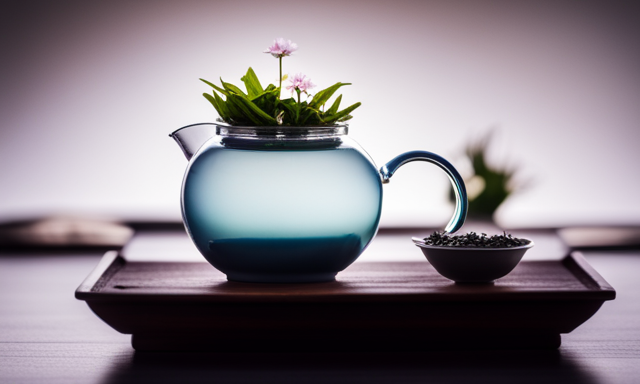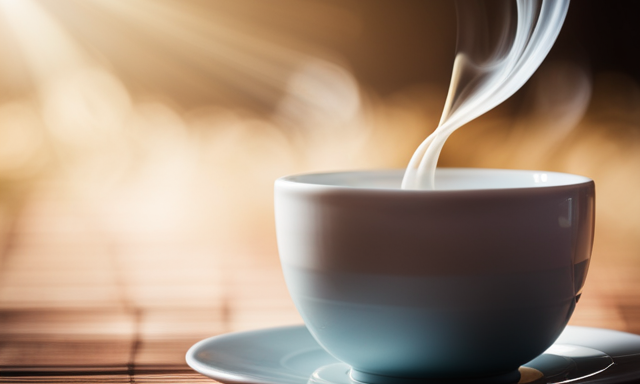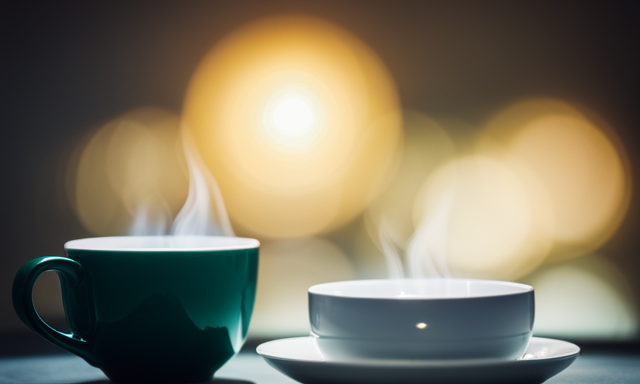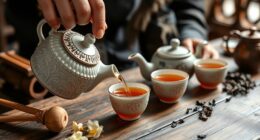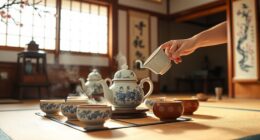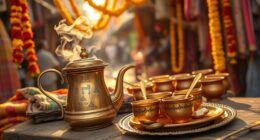Ah, oolong tea. The exquisite elixir that has captured the hearts and palates of tea enthusiasts all over the world. Allow me to be your guide on this journey of discovery, as we unravel the secrets and wonders of this remarkable beverage.
Picture this: a tea that lies somewhere between the realms of green and black, offering a tantalizing balance of flavors and aromas. Oolong tea, my dear reader, is precisely that. With its origins deeply rooted in the tea-growing regions of China and Taiwan, this glorious infusion has been cherished for centuries.
In this article, we will delve into the origins, processing methods, and different types of oolong tea. We will explore its diverse flavor profiles and uncover the myriad health benefits it provides. We will also delve into the fascinating relationship between oolong tea and Chinese tea culture, as well as its popularity across the globe.
So, sit back, relax, and prepare to embark on a captivating journey through the world of oolong tea. Trust me, it’s a journey you won’t want to miss.
Key Takeaways
- Oolong tea is a type of tea that is known for its rich roasted flavors and can be steeped multiple times.
- Oolong tea has various health benefits, including boosting metabolism, promoting weight loss, reducing the risk of heart disease, and improving cardiovascular function.
- Brewing techniques for oolong tea involve using water at a specific temperature and steeping for a certain amount of time to fully develop flavors and release the complex flavors of the leaves.
- Oolong tea is deeply ingrained in Chinese and Taiwanese tea culture, symbolizing harmony, respect, and mindfulness, and encourages community and connection.
The Origins of Oolong Tea
Oolong tea, with its rich history and complex flavors, traces its origins back to the mountains of Fujian province in China. The cultivation process of oolong tea is meticulous and requires skilled hands. The tea leaves are carefully selected, plucked, and then withered under the sun.
After withering, the leaves undergo a process of oxidation that is carefully controlled to achieve the desired flavor profile. This oxidation process is what sets oolong tea apart from other types of tea, as it falls between green and black tea in terms of oxidation levels.
The different grades of oolong tea are determined by the quality of the leaves and how long they are oxidized. From lightly oxidized teas with floral and fruity notes to heavily oxidized teas with robust flavors, there is a wide range of oolong teas to suit every palate.
Moving on to the processing methods of oolong tea…
The Processing Methods of Oolong Tea
When it comes to the processing methods of oolong tea, there are three key points to consider.
Firstly, withering and bruising the leaves is an important step in the process. This helps to remove excess moisture and initiate oxidation.
Secondly, the oxidation and fermentation process is crucial in developing the unique flavors and aromas of oolong tea.
Finally, roasting or drying the leaves is done to stop the oxidation process and preserve the desired characteristics of the tea.
Withering and bruising the leaves
After the leaves are picked, they undergo withering and bruising, which allows the tea to develop its unique flavor profile. Withering techniques involve spreading the leaves in a thin layer and exposing them to air, causing them to lose moisture. This process softens the leaves and reduces their grassy aroma. Leaf bruising, on the other hand, is achieved by gently shaking or rolling the leaves, causing them to release enzymes and react with oxygen. This step initiates the oxidation and fermentation process, which is crucial in oolong tea production. By carefully controlling the withering and bruising, tea artisans can create a wide range of flavors and aromas in oolong tea, from light and floral to bold and roasted. The next step in the tea-making journey is the oxidation and fermentation process, which further develops the tea’s taste and aroma.
Oxidation and fermentation process
During the oxidation and fermentation process, the tea leaves undergo a transformation, developing rich flavors and complex aromas. This crucial step in oolong tea production occurs after the leaves have been withered and bruised.
Oxidation refers to the reaction between the enzymes in the leaves and the oxygen in the air. As the leaves are exposed to oxygen, they slowly turn darker in color and develop a unique flavor profile.
The fermentation process, on the other hand, involves the breakdown of compounds within the leaves by microorganisms, resulting in the production of various chemical compounds that contribute to the tea’s taste and aroma.
Apart from enhancing the sensory experience, this process also brings about health benefits, such as boosting metabolism and aiding digestion.
Moving on to the next stage, roasting or drying the leaves further enhances the tea’s characteristics, creating a delightful brew that is a true delight to savor.
Roasting or drying the leaves
Roasting or drying the leaves is like giving them a warm embrace, enhancing their characteristics and creating a delightful brew that is a true delight to savor. In the world of oolong tea, the art of roasting plays a crucial role in determining the flavor profile and aroma of the final product. Various roasting techniques and traditional drying methods are employed to achieve different results. The leaves are carefully roasted over charcoal, infusing them with a smoky essence that adds depth and complexity to the tea. Some oolong teas undergo multiple rounds of roasting to develop a rich and robust flavor, while others are lightly roasted to preserve their natural floral notes. These techniques require skill and expertise, passed down through generations, to bring out the best in the leaves. As we delve into the different types of oolong tea, we will discover the diverse flavors and characteristics that arise from this meticulous roasting process.
Different Types of Oolong Tea
Indulge yourself in the diverse array of oolong teas, each offering a unique flavor profile and aroma that will captivate your senses.
Oolong tea comes in various types, each with its own distinct characteristics. From the floral and fruity notes of green oolong to the roasted and nutty flavors of dark oolong, there is a taste to suit every palate.
When brewing oolong tea, it is essential to consider the best temperature for extracting its full potential. Generally, a brewing temperature of around 185°F to 205°F is recommended to bring out the complex flavors and aromas of oolong tea.
As we delve into the flavor profiles of oolong tea, you will discover the intricate nuances and delightful surprises that await with each sip.
Flavor Profiles of Oolong Tea
When exploring the flavor profiles of Oolong tea, one can expect to encounter a delightful array of notes.
Floral and fruity flavors are often present, providing a refreshing and aromatic experience.
Additionally, Oolong tea can exhibit creamy and buttery undertones that offer a luxurious and smooth sensation.
For those seeking a more robust taste, some Oolong teas feature roasted and earthy flavors, adding depth and complexity to the overall profile.
Floral and fruity notes
Oolong tea has a delicate blend of floral and fruity notes that transport your senses to a serene garden in full bloom. The floral flavors of oolong tea range from subtle hints of jasmine and orchid to more robust rose and lavender. These floral notes create a refreshing and calming experience, perfect for enjoying a moment of relaxation.
The fruity flavors found in oolong tea can vary from citrusy and tropical notes to sweet and juicy undertones. These flavors add a touch of brightness and complexity to the tea, making it a delightful choice for any occasion.
When it comes to tea pairing suggestions, oolong tea pairs wonderfully with light and fruity desserts, such as peach cobbler or lemon bars. The floral and fruity notes of oolong tea seamlessly transition into the subsequent section about creamy and buttery flavors, creating a harmonious taste experience.
Creamy and buttery flavors
The creamy and buttery flavors of oolong tea dance on the palate, leaving a velvety smooth sensation that lingers with each sip. This exquisite tea boasts a creamy texture that coats the mouth, creating a luxurious drinking experience. The buttery aroma wafts from the cup, enticing the senses and preparing the palate for the indulgence to come. As the tea steeps, the flavors develop, revealing a delicate balance of creaminess and butteriness. The notes intertwine harmoniously, creating a symphony of taste that is both satisfying and comforting. To evoke the emotions associated with this sensory journey, imagine a table adorned with a delicate tea set, surrounded by soft candlelight, and a gentle breeze carrying the scent of fresh flowers. As we transition to the next section about roasted and earthy undertones, we embark on a new exploration of flavors that will further deepen our appreciation of oolong tea’s complexity.
Roasted and earthy undertones
Immerse yourself in the world of oolong tea as it unveils its hidden depths, revealing roasted and earthy undertones that transport you to a rustic, serene landscape.
To fully appreciate the rich roasted flavors of oolong tea, follow these brewing tips:
-
Water temperature: Use water that is around 190°F (88°C) to bring out the roasted notes without scorching the leaves.
-
Steeping time: Allow the leaves to steep for about 3-5 minutes to extract the full flavor profile.
-
Tea to water ratio: Use approximately 1 teaspoon of oolong tea leaves for every 8 ounces of water to achieve a well-balanced brew.
-
Multiple infusions: Oolong tea leaves can be steeped multiple times, with each infusion revealing different layers of flavors.
As you savor the robust taste of oolong tea, you’ll also be reaping its numerous health benefits.
Transitioning into the next section, let’s explore the various ways oolong tea can enhance your well-being.
Health Benefits of Oolong Tea
Try incorporating oolong tea into your daily routine and experience how it can boost your metabolism, with studies showing it can increase fat burning by up to 10%. Oolong tea has been linked to weight loss due to its ability to enhance fat metabolism and improve insulin sensitivity. Additionally, it contains antioxidants that promote heart health by reducing the risk of heart disease and lowering blood pressure. The combination of catechins, theanine, and caffeine found in oolong tea can improve overall cardiovascular function.
To help you understand the benefits of oolong tea, here is a table outlining its potential health benefits:
| Health Benefits of Oolong Tea |
|---|
| Boosts Metabolism |
| Promotes Weight Loss |
| Improves Heart Health |
| Reduces Blood Pressure |
In the next section, we will explore the various brewing techniques for oolong tea, allowing you to enjoy its flavors and reap its health benefits to the fullest.
Brewing Techniques for Oolong Tea
To fully savor the rich flavors and maximize the health benefits of oolong tea, it’s essential to master the art of brewing with different techniques.
One key aspect to consider is the brewing temperature. Oolong tea is best brewed at a temperature between 180°F and 205°F (82°C to 96°C). This allows the leaves to unfurl and release their complex flavors without becoming bitter.
Another important factor is the steeping time. Oolong tea should be steeped for about 3 to 5 minutes. This allows the flavors to fully develop and creates a balanced cup of tea.
By paying attention to both the brewing temperature and steeping time, you can experience the true essence of oolong tea.
Moving forward, let’s explore the fascinating relationship between oolong tea and Chinese tea culture.
Oolong Tea and Chinese Tea Culture
Let’s delve into the intriguing connection between oolong tea and the captivating world of Chinese tea culture. Oolong tea has long been associated with meditation and mindfulness practices in Chinese culture. Its unique balance of flavors and aromas makes it the perfect companion for quiet reflection and relaxation. In traditional Chinese ceremonies, oolong tea holds a significant place, symbolizing harmony and respect. These ceremonies are steeped in centuries of history and tradition, where every step is carefully executed to honor the tea and the person serving it. To further highlight the importance of oolong tea in Chinese culture, let’s take a closer look at the following table:
| Oolong Tea and Meditation | Oolong Tea and Traditional Chinese Ceremonies | Oolong Tea and Chinese Tea Culture |
|---|---|---|
| Promotes calmness and focus | Symbolizes harmony and respect | Rich history and tradition |
| Enhances relaxation | Demonstrates mindfulness and gratitude | Intricate brewing techniques |
| Stimulates the senses | Encourages community and connection | Deep appreciation for tea |
Now, let’s explore how oolong tea has traveled and evolved around the world, showcasing its versatility and global appeal.
Oolong Tea Around the World
Oolong Tea has become increasingly popular in various countries, each embracing the unique flavors and aromas it offers. In Japan, for example, Oolong Tea is often enjoyed during traditional tea ceremonies, honoring both the tea itself and the cultural heritage it represents. Similarly, in Taiwan, Oolong Tea is deeply ingrained in their tea culture, with tea houses offering a wide range of Oolong varieties for tea enthusiasts to savor.
Aside from its cultural significance, Oolong Tea also boasts numerous health benefits. Rich in antioxidants, it aids in digestion, boosts metabolism, and promotes overall well-being. Its unique combination of caffeine and L-theanine provides a gentle energy boost without the jitters, making it an excellent choice for those seeking a natural alternative to coffee.
As we delve into the next section on Oolong Tea and sustainability, we will explore how this remarkable tea continues to captivate us, not only through its cultural traditions and health benefits but also through its commitment to environmental stewardship.
Oolong Tea and Sustainability
As you delve into the next section, you’ll discover how this remarkable beverage’s commitment to environmental stewardship continues to captivate and inspire.
Oolong tea’s impact on the environment is a topic of great importance. The sustainable practices in oolong tea production have made it a leader in the tea industry.
Oolong tea farmers prioritize organic cultivation methods, minimizing the use of pesticides and synthetic fertilizers. They also implement water conservation techniques, ensuring that precious resources are not wasted.
Additionally, many oolong tea producers are actively involved in reforestation efforts and promoting biodiversity on their farms. These sustainable practices not only benefit the environment but also result in high-quality teas that are free from harmful chemicals.
With oolong tea’s commitment to sustainability, it’s no wonder that exploring oolong tea varieties and brands is an exciting journey.
Exploring Oolong Tea Varieties and Brands
There are countless varieties and brands of this remarkable beverage just waiting to be explored. Oolong tea, known for its unique flavor and health benefits, offers a wide range of options for tea enthusiasts. From light and floral to dark and robust, each variety brings its own distinct characteristics to the table. To help you navigate this diverse world of oolong tea, here are three popular varieties and brands:
| Variety | Flavor Profile | Brewing Method |
|---|---|---|
| Tie Guan Yin | Floral and fruity | Gongfu |
| Da Hong Pao | Robust and earthy | Gongfu |
| Oriental Beauty | Sweet and honey-like | Western |
When brewing oolong tea, it is important to follow the proper methods to fully enjoy its benefits. Start by preheating the teapot and cups, then use water at around 195°F and steep the leaves for 3-5 minutes. Experiment with different brewing techniques and explore the world of oolong tea to find your perfect cup.
Frequently Asked Questions
How many calories are in a cup of oolong tea?
A cup of oolong tea typically contains around 2 calories. Despite its low calorie content, oolong tea offers numerous health benefits, such as aiding in weight loss, improving heart health, and boosting metabolism.
Can oolong tea help with weight loss?
Oolong tea benefits weight loss due to its ability to increase metabolism. It contains catechins that help burn fat and boost energy expenditure. Incorporating oolong tea into a healthy lifestyle can support weight loss efforts.
Is oolong tea safe to consume during pregnancy?
During pregnancy, it is generally safe to consume oolong tea in moderation. While it may have potential benefits, it’s important to consult with a healthcare professional regarding the recommended daily intake for you.
What is the caffeine content in oolong tea compared to other types of tea?
The caffeine content in oolong tea is moderate compared to other types of tea. Oolong tea also provides various benefits for skin health, making it a popular choice for those looking to improve their complexion.
Are there any potential side effects or risks associated with drinking oolong tea?
Are there any potential side effects or risks associated with drinking oolong tea? While oolong tea offers potential health benefits, it is important to consume it in moderation. The recommended daily intake is 2-3 cups.
Conclusion
In conclusion, oolong tea is a fascinating beverage. It offers a unique combination of flavors and health benefits. It has a rich history in Chinese tea culture and is now enjoyed around the world.
One interesting statistic is that oolong tea production requires a significant amount of skilled labor. Each tea leaf is carefully handpicked and processed. This highlights the dedication and craftsmanship involved in creating this exquisite tea.
So, the next time you sip on a cup of oolong tea, remember the hard work and expertise that went into making it.


